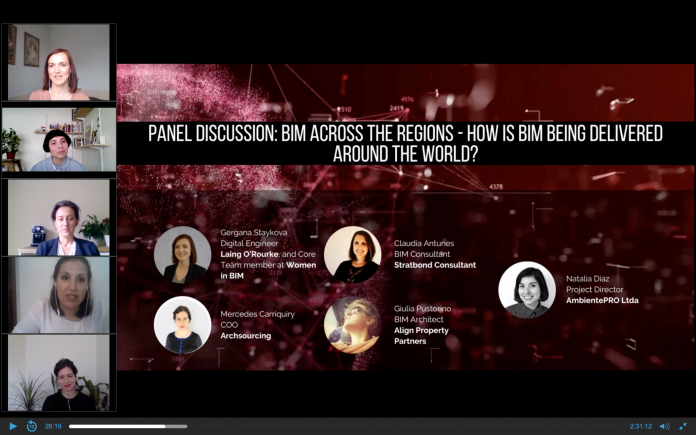In July, Women in BIM (WIB) hosted a webinar for the online Festival of BIM & Digital Construction, featuring a discussion on BIM Across the Regions. Here, the panellists examine the topics raised and their experience of BIM around the world
The webinar was moderated by core WIB team member Gergana Staykova. Gergana has been part of the digital engineering team at Laing O’Rourke for six years, working on many high-profile projects across the UK. Having grown up in Bulgaria, studied in Denmark and worked in Germany and the UK, Gergana was able to immerse herself in the international topic of discussion and explore the differences and similarities of BIM adoption across the regions with great interest.
Gergana’s questions were answered by a panel of WIB regional leads, representing different corners of the world: Claudia Antunes, BIM consultant at StratBIM from Coimbra, Portugal; Giulia Pustorino, BIM architect at Align Property Partners from Cumbria, UK; Mercedes Carriquiry, founder of BIM consulting and production specialist /ARCHSOURCING from Montevideo, Uruguay; and Natalia Diaz, project director at AmbientePRO from Santiago, Chile.
The panel discussion began with a conversation about the experiences of the speakers around female participation in BIM and digital construction roles in their regions. This was followed by a showcase of technical expertise and passion for innovation by the panellists during their exploration of topics such as BIM adoption and implementation, the role of standards, the existing misconception that BIM equals a piece of software and the untapped potential of information continuity through the project stages.
The topics discussed by the panel certainly sparked great interest amongst the live audience and here we have captured just some of what some our panellists had to say about their career experiences and an overview of what they brought to the debate.
Natalia Diaz, project director at AmbientePRO, Santiago, Chile 
Chile is the first Latin American country to develop a national BIM strategy driven by the government. It is also a pioneer in establishing the Latin American governments’ BIM group in 2018 alongside Argentina, Brazil, Chile, Mexico and Uruguay. The organisation became official in 2019 with Chile as the first president. The group includes eight countries that work together to improve the productivity of the AEC industry through digital transformation, supporting BIM implementation in the different nations with a collaborative regional approach.
Since 2015, Chile has been on a fascinating journey, which officially started with the definition of a national BIM strategy. At the start, the focus was working with public institutions to understand their processes and workflows. This period has been vital in promoting the principles of BIM among industry stakeholders. Proof of this is the increasing number of local conferences, seminars and workshops related to the topic in recent years.
Another stream of work has been focused on filling the gap in BIM skills at different educational levels. For instance, the inclusion of BIM in universities’ and technical schools’ curricula, but also the development of training programmes for existing professionals. The government and private sector have collaborated to fund these initiatives.
As part of the Chilean BIM mandate, the definition of a common BIM standard was required. The document was launched in June 2019, and it is aligned with international standards such as ISO 19650. In 2020, we are expecting a number of public projects to include the BIM standard as part of their requirements. The first project will be a social housing scheme located in Santiago de Chile.
In Chile, we have a significant presence of women working in BIM. There is a group of remarkable women defining the national BIM strategy, developing the national standards and implementing BIM in the public sector. In fact, the governmental BIM programme and the Latin American BIM group are led by a woman. There are other groups of professionals working on private projects, in technical and academic roles. It is fantastic to recognise women working in key positions across the Chilean BIM sector but at this moment, we lack figures promoting their positive impact on the industry. The next challenge is building a local community of women in BIM roles in order to contribute to BIM adoption.
Mercedes Carriquiry, founder of /ARCHSOURCING, Montevideo, Uruguay 
I believe BIM is the tipping point of an industry shift. Technology in the AEC industry is a blank spot currently being disruptively developed by few brave visionaries. There is a lot of room for further research, innovation, process improvement and business – we should all see this as an opportunity to take the lead before anything else.
There is certainly asymmetry in terms of gender presence in the AEC industry and technology roles. Yet, it is unrealistic to expect that closely measuring it will make this pivot. I am thankful for having met inspiring people along the way who pushed me to grow, I am part of WIB to give back and help empower more people to take the lead.
It is no news that BIM adoption is growing at a world scale, no matter how early adopter or laggard a country can be, there is a clear step in that direction. However, it is hard to see a common skeleton to all phases of a project. Rarely does data continuously flowing from conceptual design and feasibility studies to fabrication and maintenance, which is why we need a more unified, open-sourced approach.
During the first year of /ARCHOSURCING, we still did some CAD development and used to charge less for a project if it was developed in CAD rather than Revit. But we were wrong and fell into the market BIM denial mindset and trap. During the panel, I admitted our initial mistake and that we should have charged the same for both CAD and Revit. As an industry, we remain anchored to age-old techniques and non-data-friendly individuals and these are holding us back.
Giulia Pustorino, BIM architect at Align Property Partners, North Yorkshire, UK 
I likened BIM from the very beginning as a revolution, similar to what happened with photography when digital cameras arrived in the market at an accessible price. I remember that many of my friends said: “I will never give up my film camera for a digital one”. How many of us own a film camera now?
I started educating myself about BIM in 2013, while working as an architect in Pisa, Italy. I travelled to Zurich to meet an architect researching BIM, who showed me project examples and this was a turning point in my career. I was thirsty for more knowledge; however, few people in Italy were aware of BIM and my colleagues discouraged me from studying it further.
I moved to the UK three years ago, looking for a more stimulating environment. That, to some extent, I found. BIM is the elephant in the room – something that many in the construction sector strive to achieve. Especially in the North of England, where there are big public sector projects, the use of BIM is fundamental. Unfortunately, there is still a lot of confusion and, in my experience, the misunderstanding that BIM is Revit is very common. This lack of knowledge is my biggest fear. If our colleagues fail to understand the real power of BIM methodology, we will end up with generational conflict.
It is my goal to understand how people with advanced technology skills can support the rest – how can we introduce BIM without leaving anyone behind? For me, the role of senior management is fundamental in this process and I always look for open-minded colleagues who want to discuss the advantages of BIM adoption.
Creating a 3D model reduces the number of clashes on site, but the key part is changing the processes that we follow during design. Early collaboration is the way to deliver projects on time and budget.
The real push for BIM implementation will come when we move the focus from BIM as a visualisation software to BIM as “Better Information Management”. Everyone in the construction sector has a fundamental contribution to BIM, and it is important, that all those involved understand that in order to achieve it collaboration is mandatory.
The views of our panellists are echoed throughout the industry, with many digital construction professionals passionate about the need for greater understanding and acceptance for true industry digitalisation. Every day we are growing closer but there is still a hill to climb before we reach true unification. For WIB, we are campaigning for this day to come in the not too distant future.
Gergana Staykova
Core team
Women in BIM














